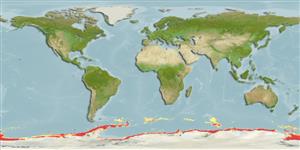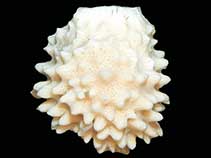Rossella racovitzae Topsent, 1901
| Native range | All suitable habitat | Point map | Year 2050 |

|
| This map was computer-generated and has not yet been reviewed. |
| Rossella racovitzae AquaMaps Data sources: GBIF OBIS |
Classification / Names Common names | Synonyms | CoL | ITIS | WoRMS
Hexactinellida | Lyssacinosida | Rossellidae
Environment: milieu / climate zone / depth range / distribution range Ecology
Sessile; depth range 18 - 2000 m (Ref. 89939). Polar
Distribution Countries | FAO areas | Ecosystems | Occurrences | Introductions
Antarctic.
Length at first maturity / Size / Weight / Age
Maturity: Lm ? range ? - ? cm
Short description Morphology
Color: white, yellow, or orange. Growth form: varies from large to barrel or vase shaped for adults around 50 cm high; or vase or egg shaped for budding types up to 15 cm high (Ref. 089939).
Deposits spicules on soft substrates, eventually forming hard mats that is important in colonization. Suspension feeder. Photosynthetic diatoms are present within its cells, but role is still unclear. Reproduction is both sexual and asexual (Ref. 089939).
Life cycle and mating behavior Maturity | Reproduction | Spawning | Eggs | Fecundity | Larvae
Members of the class Hexactinellida are hermaphroditic. Life cycle: The zygote develops into trichimella larva (free-swimming) before settling down on a substrate where it grows into a young sponge.
Main reference
References | Coordinator | Collaborators
Andrew, N. and M. Francis. 2003. (Ref. 82739)
IUCN Red List Status (Ref. 130435)
CITES status (Ref. 108899)
Not Evaluated
CMS (Ref. 116361)
Not Evaluated
Threat to humans
Harmless
Human uses
| FishSource |
Tools
More information
Internet sources
BHL | BOLD Systems | CISTI | DiscoverLife | FAO(Publication : search) | Fishipedia | GenBank (genome, nucleotide) | GloBI | Gomexsi | Google Books | Google Scholar | Google | PubMed | Tree of Life | Wikipedia (Go, Search) | Zoological Record
Estimates based on models
Preferred temperature
(Ref. 115969): -1.9 - 1.4, mean -0.6 (based on 1968 cells).



